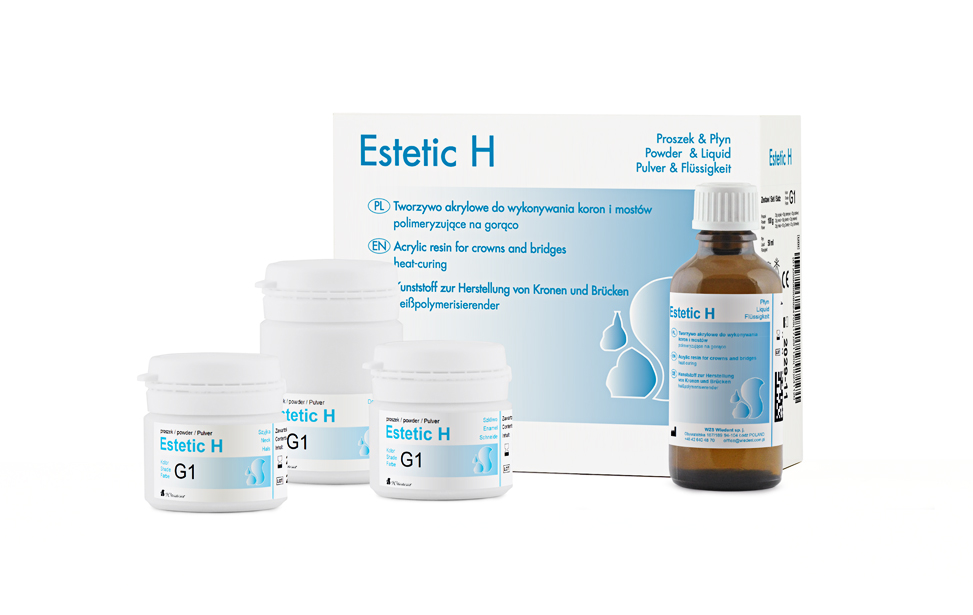Estetic H 
heat - curing acrylic resin for crowns and bridges

- enables making three layer facings imitating natural teeth, containing of neck, enamel and dentine,
- characterizes by colour stability,
- the hardness of the crowns made of Estetic H imitate the hardness of natural teeth,
- manufactures in accordance with two shade guides: universal V (A1-D4) and WIEDENT (A1 – R5),
- meets the requirements of PN-EN ISO 10477.
Technical data:
- mixing ratio: powder/liquid by weight - 2:1,
- dough time: 15 minutes,
- working time: 13 minutes,
- curing time: 2 x 20 minutes at 100°C,
- residual monomer content: 1,33 %,
- fracture strength: min. 72,2 Mpa,
- deflection module: 2334 MPa,
- water solubility: max. 0,1 μg/mm3,
- water sorption: max. 23,1 μg/mm3.
Packaging:
Sets:
- 100 g powder (25 g neck, 50 g dentin, 25 g enamel), 50 ml liquid:
- in 16 shades of universal V shade guide
- in 12 shades of WIEDENT shade guide (without B2), - 500 g powder, 250 ml liquid in two sets:
V shades: (60 g dentin in A1, A2, A3, A4, B2 shades; 40 g dentin in C2, D3 shades; 60 g neck and enamel in A3 shade);
WIEDENT shades: (60 g dentin in A1, G1, G2, N3 , R1 shades; 40 g dentin in B3, R5 shades; 60 g neck and enamel in G2 shade).
Application:
- material for facing of crowns and bridges
Properties:
- characterizes by a colour stability,
- the hardness of the crowns made of Estetic H imitate the hardness of natural teeth,
- manufactures in accordance with WIEDENT and V shade guides,
- complies with the requirements of international standard PN-EN ISO 10477.
Proportions for mixing:
Recommended weight proportions of powder and liquid are like 2:1
Direction for use and curing:
Pour appropriate amounts of the solvent into two vessels and gradually add to one the powder marked DENTIN of appropriate color, and to the other the powder marked NECK. Stir for several seconds avoiding formation of air bubbles. Cover the vessels tightly and keep under cover for ca. 15 min (depending on the temperature of the environment). Higher temperatures accelerate initial swelling. Check plasticity with a spatula. If ductile threads adhere to the spatula when it is removed from the mass, the material is ready for molding. Mold the shell crown or facings modeled in wax according to the commonly used method. After opening the mold, melt off the wax and applying an isolating layer onto plaster surface, cool the mold to room temperature. Apply a thin layer of Estetic Ekri – priming opaquer onto metal surfaces to be faced and leave to dry completely. Place plastic NECK material in the neck portion of the denture, forming the remaining part of the DENTIN material. Form the junction site with spatula and wet with the monomer to obscure the borderline between the layers. Press through wet cellophane layer with gradually increased pressure, and leave for min. 1 minute. After insert in the polymerizing tin in a polymerizing frame and immerse the frame in boiling water and maintain the boiling temperature for 20 min. Turn off the heat source, cool the mold to room temperature and open. Abrade the faced surface to prepare it for ENAMEL layer application. File off a 1-1.5mm layer off the incisal edges and cusps, with gradual reduction of filed-off thickness towards the neck. Mix the ENAMEL powder with the solvent in the same way as DENTIN and NECK material. Apply the solvent onto the filed facing surface, then apply the plastic material, form and mold under pressure. Polymerize as described above. Process and polish with generally used methods.
The manufacturer recommends the following guidelines to be included in instructions for the patients:
- crowns and bridges made up of Estetic H should be washed with a tooth-brush and toothpaste,
- damaged crowns and bridges should be repaired only by a dental technician or a dentist,
- the adjustment of crowns and bridges should be regularly checked by a dentist.
Storage:
Keep in tightly-closed containers in well-ventilated rooms. Keep out of the reach of children.
Best before: 3 years from the date of production.
WARNING:
The liquid is inflammable and also irritant. Avoid inhaling the vapours and prevent any contact with the skin and eyes. In case of contact, rinse thoroughly with water and, if any, contact your ophthalmologist. Don't dispose of the remainder of the liquid into the sewer. Dental technicians are warned against inhaling dust while carrying out prosthesis work. When engaged in this work, using of a dust-mask and a fume cupboard is recommended.
- Instruction
- Instructions for use of Estetic H
- Declaration of Conformity
- Declaration of Conformity Estetic H
- Order form
- Auxiliary products
- Safety Data Sheet
- SDS_Est_Est H_Est Ekri_liquid
- Catalogue page
- Estetic H
